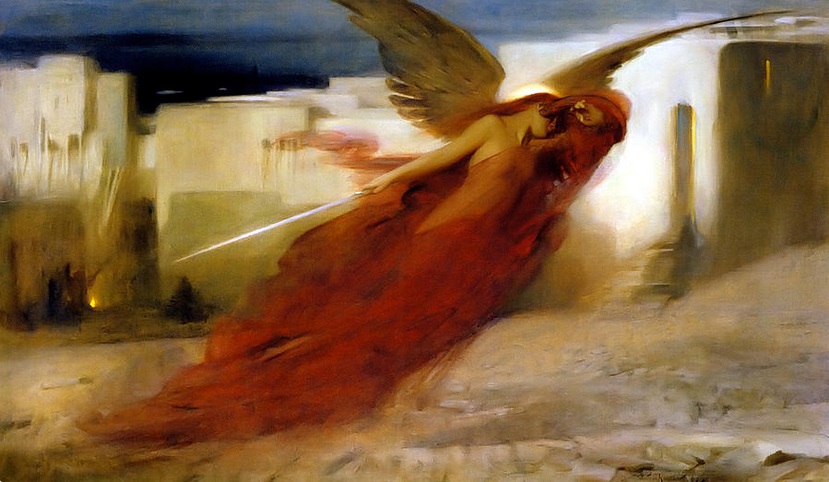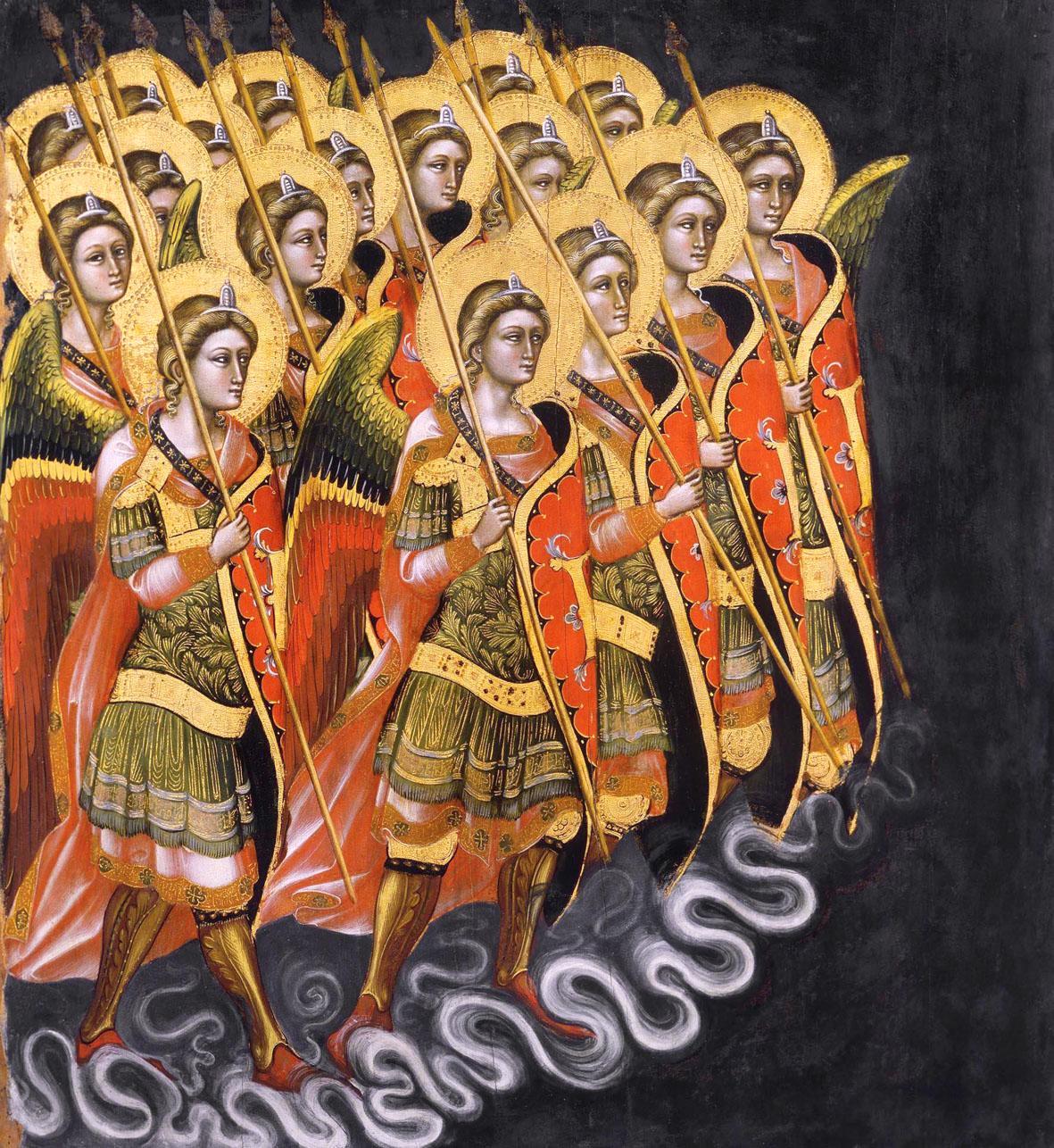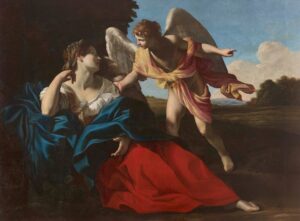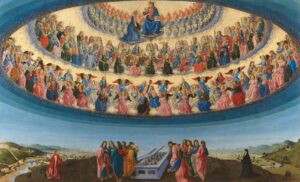Featured image: Angels’ Army, by Guariento di Arpo. Public domain, via Wikimedia Commons.
Key Takeaways
- Warrior angels protect divine order – In Christian mythology, Powers and Principalities are warrior angels who guard against cosmic and earthly threats.
- The Powers guard the cosmos – The angelic choir of Powers serves as enforcers of cosmic order, preventing demonic forces from disrupting creation.
- Principalities oversee nations and leaders – Principalities are believed to guide and protect nations, influencing rulers to uphold divine justice and moral order.
- The Bible portrays angels in spiritual warfare – Both the Old and New Testaments depict angels in direct combat with evil forces, especially in apocalyptic passages.
- Iconography emphasizes angelic power – Swords, shields, and armor in art highlight the strength and authority of warrior angels as defenders.
- Theological views on angels vary – Interpretations of warrior angels range from literal beings engaged in spiritual battles to symbolic representations of divine justice.
In a turbulent world, the idea of divine protectors watching over humanity has long held a powerful allure. Among the ranks of Christian angelic beings, some are not merely messengers but fierce warriors, battling cosmic forces of darkness. These warrior angels—especially those known as the “Powers” and “Principalities”—are traditionally seen as defenders of the divine order, sent to guard both the heavens and the earth from spiritual threats. Depicted in centuries-old religious texts and majestic works of art, these celestial soldiers are a reminder of the eternal struggle between good and evil, order and chaos.
Though angels are often portrayed as gentle and serene, warrior angels reveal a very different side of the angelic host. In both the Old and New Testaments, these beings appear at key moments to fight on behalf of God and humanity, wielding divine power to vanquish evil and uphold justice. From the apocalyptic vision of Archangel Michael leading an army against Satan in the Book of Revelation, to the unnamed angel who annihilates the Assyrian army in the Old Testament, warrior angels are potent symbols of divine intervention in the face of danger.
Table of Contents
The Concept of Warrior Angels in Christian Mythology
In Christian tradition, angels are most often thought of as messengers, heavenly beings who deliver God’s word or offer guidance and protection to the faithful. Yet, woven into Christian mythology is a lesser-known but equally compelling vision of angels as warriors—powerful, sometimes fearsome beings who engage in cosmic battles on behalf of God. The concept of warrior angels highlights a side of angelic nature that reflects not only compassion but also divine justice, authority, and a fierce commitment to defending the order of creation against the forces of chaos and evil.
Historical Origins and Sources

The roots of warrior angels in Christian mythology can be traced to the Old Testament, where angels frequently act as agents of God’s wrath or protection. In these early texts, angels do not simply deliver messages; they wield swords, destroy armies, and execute divine judgment. For example, in Exodus 12:23, an angel of death is sent to kill the firstborn of Egypt, symbolizing the power of divine retribution.
Then, when Yahweh goes through Egypt to strike it, and sees the blood on the lintel and on both door-posts, he will pass over the door and not allow the Destroyer to enter your homes and strike.
– Exodus 12:23
In 2 Kings 19:35, an angel slaughters 185,000 Assyrian soldiers in one night, saving the Kingdom of Judah from destruction. These narratives portray angels as formidable protectors of God’s chosen people, ready to engage in violence when necessary to uphold divine will.
That same night the angel of Yahweh went out and struck down a hundred and eighty-five thousand men in the Assyrian camp. In the early morning when it was time to get up, there they lay, so many corpses.
– 2 Kings 19:35
As Christianity developed, particularly through the influence of early Church Fathers, the notion of warrior angels expanded into a more organized and hierarchical structure. By the Middle Ages, angelology—the study of angels—had become a formal theological discipline. Scholars like Pseudo-Dionysius the Areopagite categorized angels into choirs, with Powers and Principalities often seen as defenders of cosmic and earthly order. This structured view of angelic duties allowed theologians to reconcile the sometimes violent actions of warrior angels with the broader understanding of angels as benevolent, divine beings.
Warrior Angels Beyond Christianity
The concept of divine warriors is not unique to Christianity; it appears in many religious traditions across the world, suggesting that the archetype of the warrior angel resonates deeply within human cultures. In Hindu mythology, the goddess Durga battles demons to restore cosmic order. Similarly, Norse mythology features the Valkyries, warrior maidens who serve Odin, choosing which soldiers live or die in battle. Greek mythology includes Athena and Ares, who represent different aspects of warfare—Athena embodies strategic warfare, while Ares represents its brutal side.
These parallels demonstrate a shared cultural archetype: divine beings who actively engage in the defense of order and justice. In Christian mythology, warrior angels fulfill this role within a monotheistic framework, underscoring that even in a world governed by a single, all-powerful God, there is a need for spiritual defenders to confront and overcome evil.

The Dual Nature of Angels as Messengers and Warriors
The notion of angels as both messengers and warriors reveals a complex view of these beings in Christian thought. On one hand, angels are celebrated for their beauty, purity, and closeness to God; on the other hand, some are envisioned as soldiers in a cosmic army, ready to defend against forces that threaten creation’s stability.
This duality reflects the dual nature of God in the Bible—a deity who is both loving and merciful, yet also just and capable of wrath. Just as God is sometimes depicted as a warrior who defends His people, so too are His angels shown as enforcers of divine justice. In this way, warrior angels embody both the protective and punitive aspects of divine intervention.
The Powers and Principalities: Roles and Responsibilities
Among the angelic choirs, the Powers and Principalities hold particular significance as warrior angels, embodying divine authority and charged with defending the world from forces of darkness.
Powers (Potestates): Guardians of Cosmic Order
The Powers, or Potestates, are often depicted as enforcers of cosmic law and order. They act as a first line of defense against demonic forces, maintaining the balance of creation and restraining chaos.
- Defenders Against Evil: Powers are seen as a protective barrier between the human world and the demonic realm, often portrayed as the first responders in the cosmic struggle.
- Enforcers of Divine Will: They ensure that God’s commands are carried out across the cosmos, maintaining harmony and preventing disorder.
- Keepers of Spiritual Discipline: Powers are sometimes described as guiding the universe toward stability and righteousness, holding destructive tendencies in check.
In Christian art, Powers are often depicted as armored warriors with swords or shields, emphasizing their strength, discipline, and role as protectors.
Principalities (Principatus): Guardians of Nations and Leaders
The Principalities, or Principatus, have a more specific role tied to earthly realms. They oversee nations, cities, and leaders, serving as intermediaries between the divine and human spheres.
- Protectors of Nations and Peoples: Principalities are guardians of countries and regions, responsible for maintaining divine order in these territories.
- Guides of Rulers and Authorities: In medieval thought, Principalities influenced political structures, guiding rulers to uphold divine law.
- Instruments of God’s Justice on Earth: They work to combat corruption, oppression, and injustice within societies, aligning governance with divine principles.
Principalities are often depicted with symbols of authority, like crowns or scepters, reflecting their role as protectors of nations and intermediaries between heaven and earth.

Warrior Angels in Scripture and Apocryphal Texts
Warrior angels appear in both the Old and New Testaments at key moments of divine intervention, where they execute God’s judgment and defend the faithful. Outside the canonical Bible, apocryphal texts like the Book of Enoch offer vivid depictions of angelic warfare.
Old Testament References
- The Angel of Death in Egypt: In Exodus 12:23, God sends an angel to kill the firstborn of Egypt, embodying divine judgment.
- The Destruction of the Assyrian Army: In 2 Kings 19:35, an angel slaughters 185,000 Assyrian soldiers, saving Jerusalem from conquest.
- The Commander of the Lord’s Army: Before the battle of Jericho, Joshua encounters an angelic figure, often seen as Michael, who stands ready for battle, illustrating the angel’s role as a divine military leader.
Now when Joshua was near Jericho, he looked up and saw a man standing in front of him, grasping a naked sword. Joshua walked towards him and said to him, ‘Are you on our side or on that of our enemies?’ He replied, ‘On neither side. I have come now as the captain of the army of Yahweh.’ Joshua fell on his face to the ground, worshipping him, and said, ‘What has my Lord to say to his servant?’ The captain of the army of Yahweh answered Joshua, ‘Take your sandals off your feet, for the place where you are standing is holy.’ And Joshua did so.
– Joshua 5:13-15
New Testament References
- Angelic Intervention at Christ’s Return: In Matthew 24:31, Jesus describes angels gathering the elect, emphasizing their role in divine judgment.
- Michael’s Battle with Satan: In Revelation 12:7-9, Michael leads a heavenly army against Satan, symbolizing the ultimate defeat of evil.
And now war broke out in heaven, when Michael with his angels attacked the dragon. The dragon fought back with his angels, but they were defeated and driven out of heaven. The great dragon, the primeval serpent, known as the devil or Satan, who had led all the world astray, was hurled down to the earth and his angels were hurled down with him.
– Revelations 12:7-9
Apocryphal Texts and Extra-Biblical Traditions
- The Book of Enoch: This text describes a group of angels called the Watchers who defy God, leading to the rise of Nephilim. In response, God sends warrior angels like Michael and Gabriel to subdue these rebellious beings.
- The Testament of Solomon: This pseudepigraphal text shows angels assisting King Solomon in controlling demons, demonstrating their authority over evil.
These texts establish that angels are active participants in a cosmic struggle, acting as protectors, enforcers of divine law, and adversaries of demonic forces.
Symbolism and Iconography of Warrior Angels
The image of warrior angels has been brought to life in countless works of art, symbolizing divine protection, justice, and the struggle between good and evil.
Symbols of Warfare and Protection
- Swords: Represent divine justice, power, and authority.
- Shields: Symbolize protection and defense.
- Armor: Represents readiness for battle and spiritual resilience.
- Trumpets: Often signify divine judgment.
- Scales: Symbolize balance and judgment.
Artistic Depictions of Warrior Angels
While Powers and Principalities are recognized as warrior angels, it is Archangel Michael who has become the quintessential symbol of divine military might.
- Michael Battling the Dragon: In works like Guido Reni’s Saint Michael the Archangel, Michael is depicted triumphantly standing over Satan.
- Michael Weighing Souls: In Last Judgment iconography, Michael holds scales, emphasizing his role as both protector and judge.
- Warrior Angels in Byzantine Icons: Byzantine art often depicts angels like Michael in formal, rigid poses, highlighting their transcendent, holy nature.

Modern Cultural Representations
In books, films, and video games, warrior angels are depicted as powerful, morally complex figures who confront evil with strength and resolve. Films like Constantine and graphic novels frequently reinterpret warrior angels, showing their continued appeal as symbols of courage, justice, and hope.
Theological Interpretations and Debates
The concept of warrior angels has been a topic of debate within Christian theology, with theologians offering a range of perspectives on whether Powers and Principalities are literal beings, symbolic representations, or archetypes of human struggles.
- Church Fathers: Figures like Augustine saw the spiritual realm as a battleground where angels contend with demons, a view that emphasizes literal angelic warfare.
- Medieval Scholasticism: Thomas Aquinas held that Powers and Principalities are literal beings engaged in spiritual combat.
- Modern Views: Some modern Christians interpret warrior angels metaphorically, seeing them as symbols of the struggle for virtue and justice.
The debate over whether warrior angels are literal or symbolic reflects broader questions about the nature of Christian belief and the interpretation of scripture.
Conclusion
Warrior angels like the Powers and Principalities embody humanity’s deepest yearnings for protection, justice, and resilience. They serve as celestial soldiers who confront evil, offering a vision of justice that is both compassionate and uncompromising. Whether seen as literal beings, psychological archetypes, or mythological symbols, warrior angels captivate the imagination, offering a vision of hope that is both timeless and universal.
Their enduring appeal lies in their dual role as protectors and enforcers of divine justice, reflecting a structured cosmic order where even the fiercest battles have purpose. Warrior angels inspire courage, resilience, and a commitment to righteousness, standing as symbols of the timeless struggle to uphold good and confront evil.
In a world filled with challenges, the figure of the warrior angel endures as a powerful reminder of the strength that comes from faith, the pursuit of justice, and the unwavering conviction that good will ultimately triumph.




